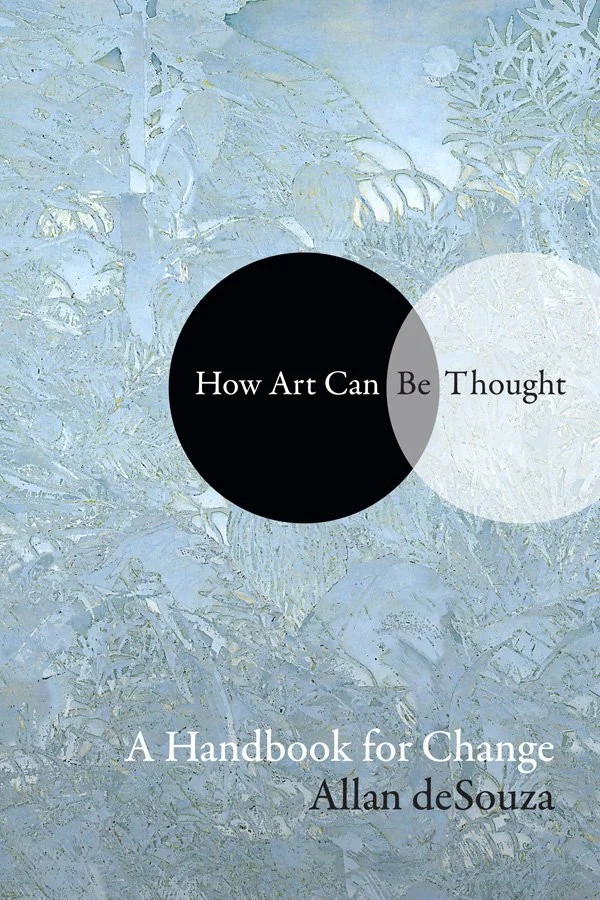How Art Can Be Thought: A Handbook for Change
Allan DeSouza | Duke University Press, 2018
Book review by Taylor Eggan
[ Originally published on Discursive Impulse in October 2018. ]
With the publication of How Art Can Be Thought, Allan deSouza has done the art world an extraordinary service, and the book’s subtitle already goes some way toward indicating the nature of that service. Despite the emphasis on “thought” announced in the first half of the title, deSouza doesn’t qualify his work as a merely speculative exercise. Indeed, his aim is far more practical. What’s on offer, then, is not “A Philosophical Inquiry,” nor “A Treatise on Pedagogical Theory.” How Art Can Be Thought is, more ambitiously, “A Handbook for Change.” And as a handbook, the work is stunning and successful—deeply informed by critical theory, yet in all aspects oriented toward practical use in the field, so to speak.
The majority of deSouza’s book takes the form of a glossary modeled on Raymond Williams’ landmark work, Keywords: A Vocabulary of Culture and Society. When Williams developed his lexicon in 1976, he did so to help fellow travelers navigate what at the time was a rapidly expanding theoretical frontier of social and cultural theory. DeSouza’s glossary also covers sprawling intellectual terrain, though in addition to spotlighting keywords in social and cultural theory he also emphasizes a host of “contested terms” of particular importance to the world of contemporary art—including, appropriately enough, both contemporary and art. In all, deSouza’s glossary encompasses just over one hundred such contested terms. His entries do not aim to be authoritative or strictly denotative. Rather than simply offering definitions, deSouza orients us toward the defining debates that animate any given term. In his own words, he seeks “to consider the various values they convey and withhold in the present.” He therefore frames rather than instructs, which turns out to be one of the keys to the pedagogical practice he unfolds over the course of the book.
Preceding deSouza’s expansive, 180-page glossary are four chapters that constitute an introductory theoretical apparatus designed to prepare the reader to use the glossary. Schematically, the first chapter addresses the challenge of defining “art”; the second considers issues of equality and diversity in art and pedagogy; the third explores the necessity of rethinking normative modes of evaluating art and artists; and the fourth takes this last point further, providing a deeply insightful discussion of the theory and practice of that art school staple, the critique seminar.
The cumulative importance of these four short chapters for how readers approach of the glossary mustn’t be underestimated. Throughout these chapters deSouza advocates for a shift from thinking about what art is to what art does and what it can do. The reason this shift has such urgency for him is that it can help quarantine, and eventually inoculate against, the notion of quality—an intrinsically damaging notion that proves disproportionately so to nonwhite and other marginalized artists. A tenuous concept at best, “quality” remains insufficiently defined and woefully underexamined. As such it comes with an extraordinarily tenacious “repertoire of exclusion.” Instead of evaluating artists and their work in terms of some pseudo-universalized idea of quality, deSouza urges his reader to examine “how artworks come into being, and how they activate and are activated by people with different interests, both historically and in the present.”
This rejection of “quality” forms the basis of deSouza’s method for decolonizing art-school pedagogy. And standing at the very center of this project is language. Language is central for deSouza because it forms the primary medium of discourse about art: “thinking and speaking about art are . . . active processes that lay the discursive foundations from which art is generated.” This, in turn, explains why he argues for a discipline-wide move from a parochializing “glossophobia” to a mode of “glossolalia” that honors the continued relevance of theoretical language. For all of its appeal in the face of theoretical language’s difficulty, deSouza insists that “plain-speak is a numbing, dumbing, colonizing language.” By contrast, theoretical language makes possible the kind of criticality required for any decolonial pedagogy. The inescapability of language in the production of meaning indicates the fundamental importance of learning (and hence teaching) to wield language with sufficient self-awareness:
If we enter into subjectivity through language (discourse), language also allows us to examine and critique the formation of that subjectivity. If our encounters with are prescripted and disciplined by Euro American art histories and their hierarchies of value, we risk remaining subject to their colonizing affects unless we can also begin to counter those affects through language.
DeSouza makes his case for the decolonizing potential of theoretical language over the course of the first four chapters, and it’s a powerful case indeed. But perhaps what’s most valuable about deSouza’s book is not how he synthesizes lessons from the emerging field of critical pedagogy and retools them for the art school. Rather, the book’s importance lies in how deSouza takes the further step to develop a wide-ranging theoretical lexicon that is readily usable. What we teachers and students of art inherit is thus a handbook—or perhaps better, a multipurpose discursive toolkit—to begin enacting the emancipatory project deSouza has so beautifully and compelling set out for us.
